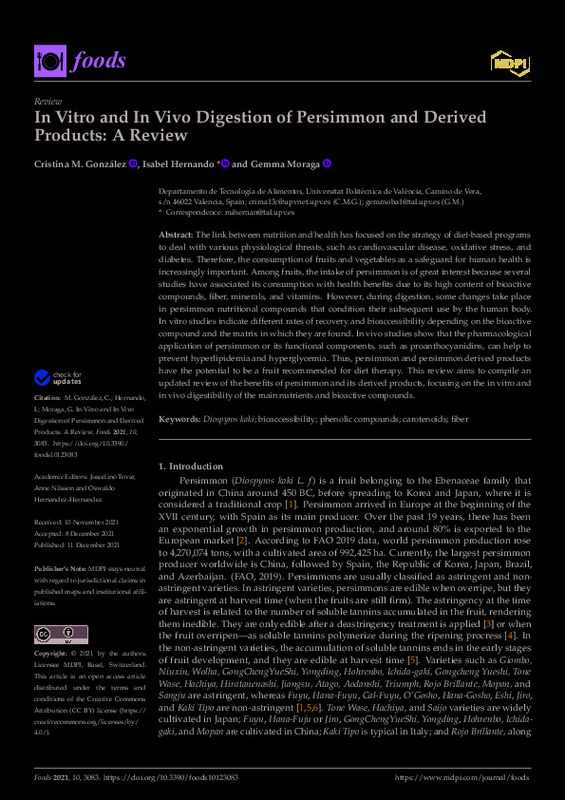JavaScript is disabled for your browser. Some features of this site may not work without it.
Buscar en RiuNet
Listar
Mi cuenta
Estadísticas
Ayuda RiuNet
Admin. UPV
In Vitro and In Vivo Digestion of Persimmon and Derived Products: A Review
Mostrar el registro sencillo del ítem
Ficheros en el ítem
| dc.contributor.author | González, Cristina M.
|
es_ES |
| dc.contributor.author | Hernando Hernando, Mª Isabel
|
es_ES |
| dc.contributor.author | Moraga Ballesteros, Gemma
|
es_ES |
| dc.date.accessioned | 2022-06-13T18:04:55Z | |
| dc.date.available | 2022-06-13T18:04:55Z | |
| dc.date.issued | 2021-12 | es_ES |
| dc.identifier.issn | 2304-8158 | es_ES |
| dc.identifier.uri | http://hdl.handle.net/10251/183241 | |
| dc.description.abstract | [EN] The link between nutrition and health has focused on the strategy of diet-based programs to deal with various physiological threats, such as cardiovascular disease, oxidative stress, and diabetes. Therefore, the consumption of fruits and vegetables as a safeguard for human health is increasingly important. Among fruits, the intake of persimmon is of great interest because several studies have associated its consumption with health benefits due to its high content of bioactive compounds, fiber, minerals, and vitamins. However, during digestion, some changes take place in persimmon nutritional compounds that condition their subsequent use by the human body. In vitro studies indicate different rates of recovery and bioaccessibility depending on the bioactive compound and the matrix in which they are found. In vivo studies show that the pharmacological application of persimmon or its functional components, such as proanthocyanidins, can help to prevent hyperlipidemia and hyperglycemia. Thus, persimmon and persimmon derived products have the potential to be a fruit recommended for diet therapy. This review aims to compile an updated review of the benefits of persimmon and its derived products, focusing on the in vitro and in vivo digestibility of the main nutrients and bioactive compounds. | es_ES |
| dc.description.sponsorship | Grant RTA2017-00045-C02-02 funded by MCIN/AEI/ 10.13039/501100011033 and, by ERDF A way of making Europe. | es_ES |
| dc.language | Inglés | es_ES |
| dc.publisher | MDPI AG | es_ES |
| dc.relation.ispartof | Foods | es_ES |
| dc.rights | Reconocimiento (by) | es_ES |
| dc.subject | Diospyros kaki | es_ES |
| dc.subject | Bioaccessibility | es_ES |
| dc.subject | Phenolic compounds | es_ES |
| dc.subject | Carotenoids | es_ES |
| dc.subject | Fiber | es_ES |
| dc.subject.classification | TECNOLOGIA DE ALIMENTOS | es_ES |
| dc.title | In Vitro and In Vivo Digestion of Persimmon and Derived Products: A Review | es_ES |
| dc.type | Artículo | es_ES |
| dc.identifier.doi | 10.3390/foods10123083 | es_ES |
| dc.relation.projectID | info:eu-repo/grantAgreement/AGENCIA ESTATAL DE INVESTIGACION//RTA2017-00045-C02-02//DISEÑO DE ALIMENTOS DE ALTO VALOR NUTRITIVO CON INGREDIENTES OBTENIDOS A PARTIR DEL DESTRIO POSTCOSECHA DE CAQUI/ | es_ES |
| dc.rights.accessRights | Abierto | es_ES |
| dc.contributor.affiliation | Universitat Politècnica de València. Departamento de Tecnología de Alimentos - Departament de Tecnologia d'Aliments | es_ES |
| dc.description.bibliographicCitation | González, CM.; Hernando Hernando, MI.; Moraga Ballesteros, G. (2021). In Vitro and In Vivo Digestion of Persimmon and Derived Products: A Review. Foods. 10(12):1-15. https://doi.org/10.3390/foods10123083 | es_ES |
| dc.description.accrualMethod | S | es_ES |
| dc.relation.publisherversion | https://doi.org/10.3390/foods10123083 | es_ES |
| dc.description.upvformatpinicio | 1 | es_ES |
| dc.description.upvformatpfin | 15 | es_ES |
| dc.type.version | info:eu-repo/semantics/publishedVersion | es_ES |
| dc.description.volume | 10 | es_ES |
| dc.description.issue | 12 | es_ES |
| dc.identifier.pmid | 34945634 | es_ES |
| dc.identifier.pmcid | PMC8701093 | es_ES |
| dc.relation.pasarela | S\451924 | es_ES |
| dc.contributor.funder | AGENCIA ESTATAL DE INVESTIGACION | es_ES |
| dc.contributor.funder | European Regional Development Fund | es_ES |








